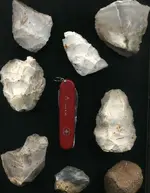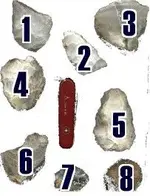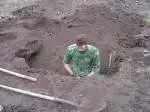You are using an out of date browser. It may not display this or other websites correctly.
You should upgrade or use an alternative browser.
You should upgrade or use an alternative browser.
schlooppy
Sr. Member
Nice finds!! Looks like you found some scrapers and some broken artifacts. If I was finding that stuff in my yard it would be torn to shreds to see what I could find.
D
diggerdood
Guest
- #3
Thread Owner
All this stuff was found around my .97 acre lot. Seems to heave from the ground during spring thaws. But I haven't found one nice point or a complete anything (yet). Was wondering, how far down do you guys usually dig? Do you just move the topsoil around, or do you go down deeper?
And does anybody know how old this stuff might be?
And does anybody know how old this stuff might be?
diggummup
Platinum Member
- Joined
- Jul 15, 2004
- Messages
- 17,824
- Reaction score
- 10,135
- Golden Thread
- 0
- Location
- Somewhere in the woods
- Detector(s) used
- Whites M6
- Primary Interest:
- All Treasure Hunting
I can't tell you how old they are.Mississippian maybe?In my experience with searching for indian artifacts,the ground was usually freshly plowed farmland searching just by sight or it was creeksides and bottoms at which we used box sifters to sort through everything.I wouldn't go past the topsoil unless something truly significant is found.
D
diggerdood
Guest
- #5
Thread Owner
Thanks Diggumup.
I showed this stuff to an old local guy, and he says, because of the rust spots (patina), that they are much older than Mississipian. I don't know if he's right, but he says the patina takes thousands of years for it to form on chert. I wouldn't know. One of the terms he used was "pre clovis" (whatever that means).
I do live right at the juncture of the Illinois and Mississippi rivers, which has been heavily populated by American indians for thousands of years.
Out in the woods behind my house, there's a deep "holler" that has been owned by the same family for a 150 years, and on the other side at the top of this holler, is a large limestone outcropping, with a shallow cave underneath. Looks to me like a good place to live, with a spring fed creek just below, and lots of wild game all around. On top of that limestone outcropping, are a bunch of chert chips. It's not hard for me to imaging some indian camping there and whileing away the time sitting there and making points and stuff, and looking for dinner at the same time.
Also along the tops of the bluffs along the river are several mounds. I hear that bluff tops were a popular place to bury dead chiefs. And just down stream there's a college called Principia that has unearthed a woolly mammoth on its property. I still haven't seen it though (http://www.zwire.com/site/news.cfm?newsid=13146283&BRD=1719&PAG=461&dept_id=25271&rfi=6). Pretty cool area to live. I just know there's a cache out there somewhere waiting for me.
I showed this stuff to an old local guy, and he says, because of the rust spots (patina), that they are much older than Mississipian. I don't know if he's right, but he says the patina takes thousands of years for it to form on chert. I wouldn't know. One of the terms he used was "pre clovis" (whatever that means).
I do live right at the juncture of the Illinois and Mississippi rivers, which has been heavily populated by American indians for thousands of years.
Out in the woods behind my house, there's a deep "holler" that has been owned by the same family for a 150 years, and on the other side at the top of this holler, is a large limestone outcropping, with a shallow cave underneath. Looks to me like a good place to live, with a spring fed creek just below, and lots of wild game all around. On top of that limestone outcropping, are a bunch of chert chips. It's not hard for me to imaging some indian camping there and whileing away the time sitting there and making points and stuff, and looking for dinner at the same time.
Also along the tops of the bluffs along the river are several mounds. I hear that bluff tops were a popular place to bury dead chiefs. And just down stream there's a college called Principia that has unearthed a woolly mammoth on its property. I still haven't seen it though (http://www.zwire.com/site/news.cfm?newsid=13146283&BRD=1719&PAG=461&dept_id=25271&rfi=6). Pretty cool area to live. I just know there's a cache out there somewhere waiting for me.
diggummup
Platinum Member
- Joined
- Jul 15, 2004
- Messages
- 17,824
- Reaction score
- 10,135
- Golden Thread
- 0
- Location
- Somewhere in the woods
- Detector(s) used
- Whites M6
- Primary Interest:
- All Treasure Hunting
I think clovis people were around in 9000 bc or somewhere around that period.Sounds like you have a great area to hunt.Do you have a metal detector?If not ,i'd get one if I were you.If your not familiar with metal detectors the Garrett Ace 250 is a good entry level detector and it's only about $200.00 if you buy off ebay.That spring fed creek near the cave sounds like a good area to detect.Not to mention the area in and around the cave.An area like is bound to have had some type of human activity besides the clovis people some 10-11000 years ago.Plus you could detect it in full nondiscrim. mode since there shouldn't be much if any new garbage out there at all.The family that owns the holler,they didn't use any of the hillside for a dump over the years did they?
D
diggerdood
Guest
- #7
Thread Owner
Whoa! 10-11k years? That's old!
No, I haven't gotten around to getting a metal detector yet. Admittedly I've been toying with the idea of getting one.Thanks for the recommendation. But since I'm also an avid scuba diver, I was kinda thinking about one that will go under with me. Which of course will make it more expensive. Any idea how much more expensive? I haven't even looked yet. And my wife does seem to get kinda fussy every time I discover a new hobby.
Yeah, this area has lots and lots of history. Lewis and Clark took off on their adventure just down the river from me.
No, I haven't gotten around to getting a metal detector yet. Admittedly I've been toying with the idea of getting one.Thanks for the recommendation. But since I'm also an avid scuba diver, I was kinda thinking about one that will go under with me. Which of course will make it more expensive. Any idea how much more expensive? I haven't even looked yet. And my wife does seem to get kinda fussy every time I discover a new hobby.
Yeah, this area has lots and lots of history. Lewis and Clark took off on their adventure just down the river from me.
Heavy Chevy
Full Member
- Joined
- Jun 18, 2005
- Messages
- 220
- Reaction score
- 2
- Golden Thread
- 0
- Location
- South Carolina
- Detector(s) used
- Bounty Hunter Tracker IV and others
Great finds diggerdood !!!
Keep up the good work !!!
Mike in SC
Keep up the good work !!!
Mike in SC
diggummup
Platinum Member
- Joined
- Jul 15, 2004
- Messages
- 17,824
- Reaction score
- 10,135
- Golden Thread
- 0
- Location
- Somewhere in the woods
- Detector(s) used
- Whites M6
- Primary Interest:
- All Treasure Hunting
I know what you mean about the wife.I'm not sure what to recommend as far as an underwater detector goes.However I believe that they start around $500-600 and up.I thought about getting one but it doesn't seem practical right now as far as the investment amount for a good one versus the amount of actual use it would get from me in the next couple of years.Maybe in a couple of years it will be a more viable option for me.I offer this though;Make sure you do your homework before you buy and invest in a good name brand one, over an offbrand cheaper model.You would also have to find one that performs well on land as well as in the water.I haven't done the research myself so i'll just say,read up and ask for advice and opinions in the beach and shallow water section of this forum.diggerdood said:Whoa! 10-11k years? That's old!
No, I haven't gotten around to getting a metal detector yet. Admittedly I've been toying with the idea of getting one.Thanks for the recommendation. But since I'm also an avid scuba diver, I was kinda thinking about one that will go under with me. Which of course will make it more expensive. Any idea how much more expensive? I haven't even looked yet. And my wife does seem to get kinda fussy every time I discover a new hobby.
Yeah, this area has lots and lots of history. Lewis and Clark took off on their adventure just down the river from me.
Cannonman17
Bronze Member
Rust spots on chert do not take 10,000 years to develope. Depending on climate, soil type, etc. oxidation spots on points can materialize within 1,000 years. Great sign of patina yes... evidence of a pre clovis people no. There is a great deal of talk about whether or not a "pre-clovis" people even existed in the Americas. If I were you I would put in a BIG garden and plow the crap out of it- I bet you would come up with some stuff that way. How deep you would have to dig would also depend on whether or not you are in what might have been the flood plain, a few floods over a couple of thousand years can pile a lot of soil on top of old sites! That overhang you speak of definately has "stuff" in it. You should at least consider talking to the local university about it, a proper excavation may be in order.
BobTheBaitFish
Jr. Member
- Joined
- Jul 13, 2007
- Messages
- 28
- Reaction score
- 2
- Golden Thread
- 0
- Location
- Highland, IL
- Detector(s) used
- Garrett CXII
I numbered your pieces and here's my opinion about them. Use wear analysis would tell you what they had been used for, but without seeing them I'm only guessing.
MATERIAL
1,2,3,4,5 are all pieces of burlington chert. There are out croppings of burlington chert in the bluffs along the mississippi and illinois river in the area.
6 & 7 look alot like Cobden / Dongala Chert but I think it's something else, but I'll get to that in a moment. Cobden / Dongala is found as nodules in southern Illinois, but is found in our area (madison county) used primarily during the Middle Woodland and Mississippian periods. Personally I think it could be some of the Nodular chert that occurs in the bluffs above the Pierre Marquette visitors center. I believe it to be nodular St Louis green chert, but unfortunately I knapped the few nodules I had years ago.
USAGE
1 A broken biface perhaps. Bifaces were a stage in reducing a hunk of chert to a blade or projectile point. They often were utilized as tools never reaching or having been intended to reach final form as a knife or projectile point. Lacking alot of secondary flaking or edge wear, I suspect yours broke while being knapped.
2 Interesting piece appears to me to have been ground on the one edge. May have been an Archaic period blade or point.
3 A piece of chert. Might have some retouch or use damage on the left hand side in the picture, suggesting it have have been used as a tool.
4 A chuck of chert, may be an exhausted core. Appears to have been utlized as a tool, most likely a knife for cutting or scraping.
5 Another chunk of chert, but most likely used as a core as it's possible to see a flake scar runing down the face of the piece. Again likely used as a tool.
6 Weathered piece of chert, with no signs of usage apparent.
7 Exhausted core. Likely a highly knappable piece of chert as it was reduced to such a small size that one could only obtain small bladelets from it.
8. Not a clue. A sedimentary rock. I've seen abraders used to sharpen bone tools made from similar materials, but I can only assume it's only a rock and not an artifact.
CONCLUSION
I assume these artifacts are likely from a site that was occupied during the late archaic to early woodland period. Archaic people of our area tended to move from site to site frequently. Over the years a single site could be occupied many times. If you find any complete or nearly complete points (arrowheads) I can give you a better estimate as to when the site was occupied.
Mike
MATERIAL
1,2,3,4,5 are all pieces of burlington chert. There are out croppings of burlington chert in the bluffs along the mississippi and illinois river in the area.
6 & 7 look alot like Cobden / Dongala Chert but I think it's something else, but I'll get to that in a moment. Cobden / Dongala is found as nodules in southern Illinois, but is found in our area (madison county) used primarily during the Middle Woodland and Mississippian periods. Personally I think it could be some of the Nodular chert that occurs in the bluffs above the Pierre Marquette visitors center. I believe it to be nodular St Louis green chert, but unfortunately I knapped the few nodules I had years ago.
USAGE
1 A broken biface perhaps. Bifaces were a stage in reducing a hunk of chert to a blade or projectile point. They often were utilized as tools never reaching or having been intended to reach final form as a knife or projectile point. Lacking alot of secondary flaking or edge wear, I suspect yours broke while being knapped.
2 Interesting piece appears to me to have been ground on the one edge. May have been an Archaic period blade or point.
3 A piece of chert. Might have some retouch or use damage on the left hand side in the picture, suggesting it have have been used as a tool.
4 A chuck of chert, may be an exhausted core. Appears to have been utlized as a tool, most likely a knife for cutting or scraping.
5 Another chunk of chert, but most likely used as a core as it's possible to see a flake scar runing down the face of the piece. Again likely used as a tool.
6 Weathered piece of chert, with no signs of usage apparent.
7 Exhausted core. Likely a highly knappable piece of chert as it was reduced to such a small size that one could only obtain small bladelets from it.
8. Not a clue. A sedimentary rock. I've seen abraders used to sharpen bone tools made from similar materials, but I can only assume it's only a rock and not an artifact.
CONCLUSION
I assume these artifacts are likely from a site that was occupied during the late archaic to early woodland period. Archaic people of our area tended to move from site to site frequently. Over the years a single site could be occupied many times. If you find any complete or nearly complete points (arrowheads) I can give you a better estimate as to when the site was occupied.
Mike
Attachments
Johnny X
Bronze Member
- Joined
- Aug 18, 2005
- Messages
- 1,178
- Reaction score
- 444
- Golden Thread
- 0
- Location
- Jerseyville Illinois
- Detector(s) used
- White's Spec. XLT..... My Eyes
Hmm.. You could be on something digger! I'd keep my eyes open in that yard of yours and take cannonmans advice and plant a BIGGGG GARDEN and plow it about every 2 weeks :P
I live about 40 miles from cahokia in good old Jersey County.
xstevenx
I live about 40 miles from cahokia in good old Jersey County.
xstevenx
Similar threads
- Suggestion
- Replies
- 68
- Views
- 2K
- Replies
- 25
- Views
- 1K
- Suggestion
- Replies
- 3
- Views
- 261
Users who are viewing this thread
Total: 1 (members: 0, guests: 1)







